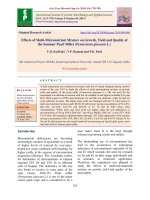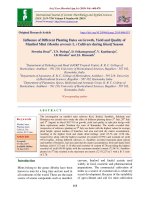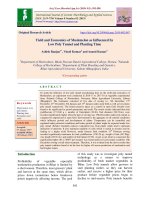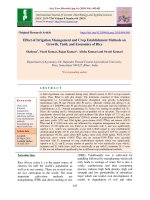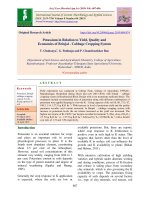Yield and economics of finger millet with different legumes in Koshi Region of Bihar, India
Bạn đang xem bản rút gọn của tài liệu. Xem và tải ngay bản đầy đủ của tài liệu tại đây (156.69 KB, 6 trang )
Int.J.Curr.Microbiol.App.Sci (2020) 9(5): 2282-2287
International Journal of Current Microbiology and Applied Sciences
ISSN: 2319-7706 Volume 9 Number 5 (2020)
Journal homepage:
Original Research Article
/>
Yield and Economics of Finger Millet with Different Legumes
in Koshi Region of Bihar, India
Binod Kumar1 and Pankaj Kumar Ray2*
1
Department of Agronomy, MBAC, Saharsa, Bihar, India
2
Krishi Vigyan Kendra, Saharsa, Bihar, India
*Corresponding author
ABSTRACT
Keywords
Finger millet,
Legumes,
Intercropping,
Yield, Economics
Article Info
Accepted:
18 April 2020
Available Online:
10 May 2020
A field experiment was conducted during the Kharif season of 2019 at
Agronomy Instructional Farm, Mandan Bharti Agriculture College,
Saharsa, Bihar Agricultural University, Sabour, Bhagalpur, Bihar to
evaluate the best finger millet based inter cropping with different legumes.
Based on the results, it was concluded that intercropping of finger millet
with black gram at 4:2 pair row ratio was distinctly superior among all
intercropping system found most profitable by realizing the highest net
return. However, yield and yield attributing characters of finger millet were
recorded significantly higher in Finger millet intercropped with Black gram
followed by groundnut and soybean. . Among the ratio of intercropping
system 4:2 ratio of all inter cropping systems recorded higher finger millet
equivalent yield along with net income than 6:2 ratio of inter cropping
system.
Introduction
Traditional intercropping system is normally
followed by many farmers to meet their
domestic demands. Selection of crops and
cropping systems in relation to soil and
climate is a key factor for successful crop
production. Intercropping is a system of
growing more than one crop species on the
same piece of land at the same time. The
benefits
perceived
or
realized
by
intercropping systems include greater land use
efficiency improvement in soil fertility.
Intern, several factors like cultivar selection,
seeding ratios, planting pattern and
competition between mixture components
affect the growth of species in intercropping
(Caballero et al., 1995, Carr et al., 2004).
Several legume species including pigeonpea,
black gram, groundnut, cowpea, soybean etc.
were evaluated for their feasibility as an
intercrop. Finger millet (Eleusine coracana L.
Ganetn) is one of the important rainfed as
well as dry land crop and is widely cultivated
2282
Int.J.Curr.Microbiol.App.Sci (2020) 9(5): 2282-2287
throughout country in dry tracks with fewer
natural resources. Growing of only cereals is
not so much remunerative in present scenario
of agriculture to fulfill the diverse demand of
consumers and rapid growing population.
Intercropping of finger millet with different
legumes has grater scope to utilize the land
and other resources to maximum extent. The
productivity of the system can be enhanced by
judicious selection of intercrop differing in
duration and growth alone in many situations
this is supported by Aravazhi et al., (1997),
Natarajan (1992) and Sadashiv and
Nemgouda (2004).
Materials and Methods
A field experiment was conducted during the
Kharif season of 2019 at Agronomy field unit,
Mandan Bharti Agriculture College, Saharsa,
Bihar Agricultural University, Sabour,
Bhagalpur, Bihar.. The legume crop of
Soybean (JS-9752), Black gram (IPU-2-43)
and Groundnut (BG-3) were taken as
intercrop in finger millet (GPU-67). The
intercrops were sown in finger millet in
different row proportions of 4: 2 and 6: 2. The
row spacing of finger millet, soybean, black
gram and groundnut were maintained at 20
cm, 40 cm, 30cm and 40cm respectively ..
The legumes crops were sown by dibbling
method. The thinning of legume crop was
done at 15 days after sowing and only one
healthy plant was kept per hill by maintaining
the 10 cm spacing between the two plants.
The experiment was laid out in randomized
block design with three replications. Ten
treatments were studied viz., T1- Sole crop of
finger millet, T2- Sole crop of Soybean, T3Sole crop of Black gram, T4- Sole crop of
Groundnut, T5- Finger millet + soybean (4:2),
T6- Finger millet+ soybean (6:2), T7- Finger
millet+ Black gram (4:2), T8 -Finger millet+
Black gram (6:2), T9- Finger millet+
Groundnut (4:2) and T10- Finger millet+
Groundnut (6:2). The gross plot size was 23 x
67 m and net plot of 6.0 x 5.40 m. The 5.0
tones of FYM/ ha with recommended dose of
fertilizers (60: 40: 25 kg NPK/ ha) was given
to the finger millet crop which was applied
through urea and single super phosphate. The
crops were sown during the first week of
June. Necessary plant protection measures
were taken to protect the crop from pest and
diseases. The intercultivation two weedings
were followed by one hoeing.
Results and Discussion
Yield attributing characters of finger millet
Table 1 show that Productive tillers per hill
and earhead length of finger millet were
significantly high in sole crop. Among
different intercroppings systems Finger millet
+ Black gram (6:2) row ratio were produced
higher number of productive tillers per hill
(3.500) and earhead length (9.803) of finger
millet. It might be due to lower density of
finger millet and wider space available for
more growth and development of finger millet
as compared to other row ratios. Bengali
(1987) and Tiwari et al., (2015) reported
similar
results.
Better
environment
particularly the light interception by outer
rows of finger millet in this row ratio lead to
higher effective tillers per hill in these
treatments or this might be due to
development of better complementary
relationship and non-renewable resources like
water, nutrients and incoming sunlight. These
results are in close conformity with the
findings of Narasimha Rao et al. (1963) and
Divakaran (1967).
The maximum number of ears/m2 (110.0) was
observed in T8- Finger millet + Black gram
(6:2) which were at par with T7 -Finger millet
+ Black gram (4:2). The minimum number of
ears/m2 was 92.0 recorded under T5- Finger
millet + Soybean (4:2).. This was due to more
number of productive tillers in T8 compared
to others. This was in accordance with earlier
finding of Rajesh (2011) in finger millet.
2283
Int.J.Curr.Microbiol.App.Sci (2020) 9(5): 2282-2287
Table.1 Yield attributing characters of finger millet as influenced by different treatments
Treatments
T1- Finger millet ( sole)
T2- Soybean (sole)
T3 -Black gram (sole)
T4 -Groundnut (sole)
T5 –Finger millet+ soybean
(4:2)
T6- Finger millet+ soybean
(6:2)
T7- Finger millet+ Black
gram (4:2)
T8 -Finger millet+ Black
gram (6:2)
T9- Finger millet+
Groundnut (4:2)
T10- Finger millet+
Groundnut (6:2)
SEM ±
CD at 5%
No of
No. of Length
productive ears/m2
of
tillers/hill
Ear head
(cm)
3.600
111.00 11.000
Wt. of No. of
ear fingers
head
/ear
(gm)
35.10 8.100
Length of
fingers
/ear (cm)
No. of grains
/ear
Test
wt.
(gm)
5.600
2401
3.800
2.717
92.00
8.567
32.40
7.017
4.630
2117
2.417
2.867
95.00
8.803
32.70
7.217
4.753
2149
2.633
3.217
105.00
9.677
34.30
7.900
5.213
2300
3.233
3.500
110.00
9.803
34.80
8.333
5.460
2395
3.653
2.920
97.00
9.200
33.10
7.420
4.863
2232
2.870
3.053
103.00
9.433
33.50
7.600
5.103
2265
3.050
0.116
0.361
0.208
0.649
0.139
0.432
0.095
0.297
0.074
0.231
0.100
0.312
12.059
37.570
0.132
0.410
2284
Int.J.Curr.Microbiol.App.Sci (2020) 9(5): 2282-2287
Table.2 Yield and economics of finger millet as influenced by different treatments
Treatments
T1- Finger millet ( sole)
T2- Soybean (sole)
T3 -Black gram (sole)
T4 -Groundnut (sole)
T5 –Finger millet+ soybean (4:2)
T6- Finger millet+ soybean (6:2)
T7- Finger millet+ Black gram
(4:2)
T8 -Finger millet+ Black gram
(6:2)
T9- Finger millet+ Groundnut
(4:2)
T10- Finger millet+ Groundnut
(6:2)
SEM ±
CD at 5%
Grain yield
of finger
millet
(kg/ha)
2017
Cost of
cultivation
(Rs/ha)
Gross
return
(Rs/ha)
1831
1865
1975
Finger millet
equivalent
yield
(kg/ha)
2017
1843
2325
2302
3521
3425
4233
17500
24700
20400
30850
24850
25300
24350
44374
68191
69750
92080
77462
75350
93126
26874
43491
49350
61230
52612
50050
68776
1.53
1.76
2.41
1.98
2.11
1.97
2.82
2010
4228
24700
93016
68316
2.76
1905
4013
26450
88286
61836
2.33
1933
3993
26800
87846
61046
2.27
5.893
18.360
2285
Net return B:C ratio
(Rs/ha)
Int.J.Curr.Microbiol.App.Sci (2020) 9(5): 2282-2287
However, Weight of ear head, number of
fingers /ear, length of fingers/ear, number of
grains/ear, test weight, was significantly high
in sole crop. Among different intercroppings
systems Finger millet + Black gram (6:2) row
ratio were produced highest Weight of ear
head, number of fingers /ear, length of
fingers/ear, number of grains/ear and test
weight. These results are in accordance with
finding of Rathore and Gautam (2003) and
Ramamoorthy et al. (2004).
Economics
The results clearly showed that sole
groundnut recorded the highest net return than
all other sole crops (Table 2). This was
mainly due to high price of groundnut.
However, the highest benefit/cost ratio was
obtained from sole black gram due to high
productivity of black gram. The lowest net
return and benefit/cost ratio was obtained
from sole finger millet, which might be due to
low productivity of the crop.
Grain and straw yield
The sole crop of finger millet recorded the
highest grain yield (2017 kg/ha) which was
significantly superior over rest of the
treatments. The grain as well as straw yield
reduced considerably when intercropped with
legumes in comparison to sole crop of finger
millet as reported by Singh and Arya (1999)
and Mitra et al. (2001). Among all the
intercropping system, the maximum yield was
recorded in the finger millet intercropped with
blackgram followed by groundnut and
soybean. However the ratio of 6:2 among all
intercropping systems recorded significantly
higher grain and straw yield than 4:2 ratio of
intercropping systems.
Grain equivalent yield of finger millet
As regards the finger millet grain equivalent
yield significantly highest yield (4233 kg/ha)
was observed by the treatment T7 where
black gram was taken as intercrop in finger
millet in 4:2 row proportion. But it was at par
with the treatment T8 where black gram was
taken as an intercrop in finger millet in 6:2
row proportions (4228 kg/ ha). Similar results
were also reported by Thorat et al. (1986),
Mahadkar
and
Khanvilkar
(1988),
Shankarlingappa and Hegade (1992) and
Ramamoorthy et al. (2004). It indicates that it
is beneficial to raise the finger millet with
intercrops rather than sole crop alone.
Monetary returns (Table-2) as elucidated by
net income were significantly higher in
different intercropping systems as compared
to sole finger millet. Looking to overall
economics all legumes and finger millet with
legume intercropping treatments gave
significantly higher net realization over that
of sole finger millet. This could be attributed
to higher yield advantage under sole legumes
and intercropping systems. Finger millet +
Black gram (4:2) combination gave the
highest net return of Rs. 68776 /ha and benefit
cost ratio of 2.82 followed by finger millet +
Black gram (6:2) which gave net return of Rs.
68316/ha with 2.76 benefit cost ratio which
confirmed the superiority of Finger millet
with black gram at 4:2 pair row ratio over
other treatments. Similar results were also
reported by Yadav and Jat (2005).
References
Aravazhi, E., S. Natarajan and Thambaraj, S.
(1997). Economics of intercropping in
chilli. South Ind. Horticul. 45:139- 194.
Bangali, M. K. (1987). Studies on pearl millet
(Pennisetum americanum L.) under
intercropping system at different
nitrogen levels, M.Sc. (Ag.) Thesis,
Sukhadia Univ. Udaipur (Raj.).
Caballero, R., Goicoechea, E. L. and Hernaiz,
P. J. (1995). Forage yield and quality of
common vetch and oat sown at varying
2286
Int.J.Curr.Microbiol.App.Sci (2020) 9(5): 2282-2287
seed ratios and seeding rates of common
vetch. Field Crops Res., 41: 135-140.
Carr, P. M., Horsley, R. D. and Poland, W.
W. (2004). Barley, oat and cereal-pea
mixtures as dryland forages in the
Northern Great Plains. Agron. J., 96:
677-684.
Diva Karan, K. (1967). Studies on age of
seedlings in ragi (Eleusine coracana
Gartn.). Madras Agric. J., 54(9):4-75.
Narasimha Rao, D. V., damodaram, G. and
Rama Moorthy, A. K. (1963).
Preliminary studies on the proper time
of sowing and plant population in
irrigated ragi in Chittoor district.
Andhra Agric. J., 15(2):208-213.
Natarajan, S. (1992). Effect of intercrops on
chilli (Capsicum annum L.) under semi
dry condition, South Ind. Horticult.
40:273-276.
Rathore, S. S. and Gautam, R. C. (2003).
Agro techniques to improve the
productivity of pearl millet + cowpea
intercropping system under dry land
conditions. Ann. Agric. Res., 24: 971975.
Sadashiv, B. Nemgouda. (2004). Production
potential of hybrid cotton (Gyssipium
hirsutum) based vegetable intercropping
systems under irrigation. M.Sc (Ag.)
thesis, University of Agriculture
Science, Dharwad, India.
Tiwari, Ranu. Yadav, R. S. and Kumawat,
Amit. (2015). Differential Competitive
ability and growth habit of pearl millet
and cluster
bean
cultivars
in
intercropping system under hyper arid
partially irrigated western plain zone.
Ind. j. Agric. Res., 49(3): 229-234.
Yadav, G. L. and Jat, B. L. (2005).
Intercropping of moth bean varieties
with pearl millet for sustainable crop
production in arid ecosystem. Ind. J.
Pulse Res., 18: 252-253.
How to cite this article:
Binod Kumar and Pankaj Kumar Ray. 2020. Yield and Economics of Finger Millet with
Different Legumes in Koshi Region of Bihar, India. Int.J.Curr.Microbiol.App.Sci. 9(05): 22822287. doi: />
2287
